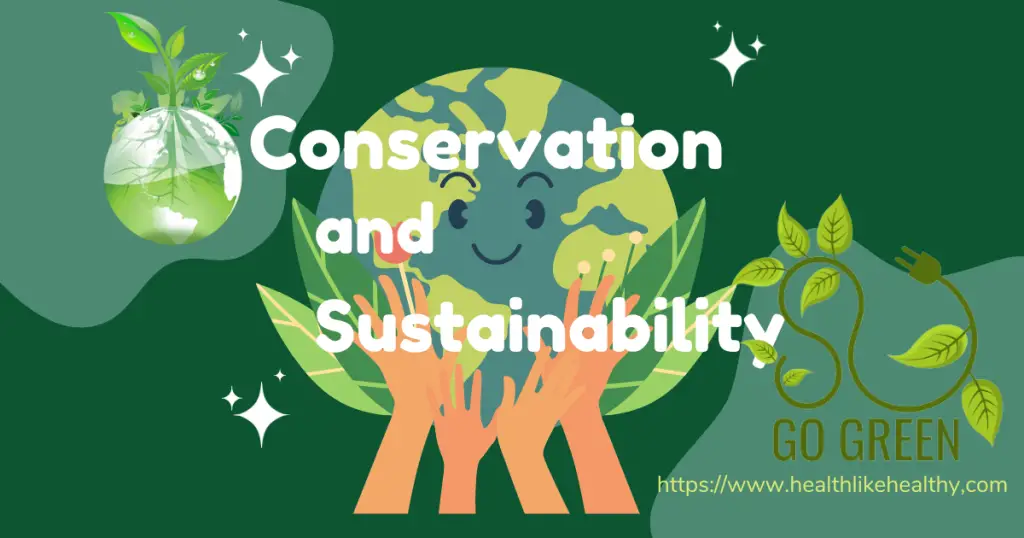Introduction:-
The most common terms, conservation and sustainability, are frequently used interchangeably regarding environmental issues. However, although they both aim to protect the planet, there are significant differences between conservation and sustainability.
The word conservation mainly concentrates on preserving and protecting natural resources. At the same time, sustainability takes a more comprehensive approach by seeking to meet the ecological, social, and economic needs of current and future generations.
Within this article, we will delve into the complexities of conservation and sustainability, examining their definitions, principles, and how they contribute to the well-being of our planet.

Conservation:-
Conservation and sustainability are related but different. Conservation protects and manages natural resources, while sustainability has a broader and long-term view.
Conservation involves reducing waste, optimizing resource use, and implementing regulations to prevent overexploitation. It aims to preserve habitats, biodiversity, and endangered species. By conserving forests, water sources, and wildlife, we ensure their availability for the future.
Biodiversity Preservation:
When we talk about biodiversity preservation, it means protecting and saving Earth’s different living things and environments. It includes efforts to keep the variety of genes, species, and ecosystems on our planet.
Biodiversity is important for ecosystems’ health and functioning and brings us many benefits. Here are some key aspects and strategies related to biodiversity preservation:
Conservation of Species:
We must protect endangered and threatened species to keep biodiversity. This means we must conserve habitats, breed animals in captivity, and create protected areas.
Habitat Conservation:
Habitat conservation is important for protecting biodiversity. Habitats provide resources and support different species, helping to maintain ecological balance. Conservation efforts include protected areas, reforestation, and sustainable land management.
Sustainable Land and Resource Use:
We should encourage sustainable practices in farming, logging, fishing, and other industries that rely on land and resources. This means using responsible land management techniques, protecting habitats, reducing pollution, and using sustainable harvesting methods.
International Cooperation and Policy:
International Cooperation and Policy: Global cooperation and coordinated efforts are necessary for preserving biodiversity.
In view of the above, The Convention on Biological Diversity (CBD) and other international agreements want to protect nature, use resources sustainably, and share benefits fairly. Governments play a key role in making rules that protect nature and promote sustainable practices.
In Montreal, Canada, the UNEP hosted COP 15 from December 7th to December 19th, 2022. Governments worldwide came together to create new goals for the next decade, until 2030, to stop and undo the damage to nature. We should understand that the significance of nature is crucial for achieving Sustainable Development Goals and reducing global warming to 1.5 degrees. We need a strong global plan to address the main causes of nature loss. This is crucial for our overall health, happiness, and the planet’s health.
Awareness and Education:
We must raise awareness about biodiversity and its importance in protecting it. Also, we can conduct educational programs that help us understand the importance of biodiversity in our daily lives and how to preserve it.
Research and Monitoring:
We need ongoing research and monitoring to understand biodiversity, find threats, and create effective conservation plans. This involves studying species populations, ecosystem changes, and the effects of human activities on biodiversity. These activities may help us advance to growing a healthy ecosystem.
Climate Change Mitigation:
Protecting biodiversity is closely linked to mitigating climate change. Increasing temperatures, habitat loss, and extreme weather events threaten ecosystems and species significantly.
It is most important to understand that we should preserve biodiversity with the help of concentration and work on reducing greenhouse gas emissions. Also, we may promote renewable energy sources and that way; we can mitigate climate change to preserve biodiversity.
Indigenous and Local Community Involvement:
Indigenous and local communities have valuable knowledge and practices that help protect biodiversity. It is important to respect their rights, support their sustainable resource management, and include them in decision-making for effective conservation.
Preserving biodiversity is a complex task that needs everyone’s help. We must take action to protect biodiversity for a better future.
Sustainability:
Sustainability means meeting current needs without harming future generations’ ability to meet their needs. It involves balancing the economy, environment, and society. To achieve sustainability, different strategies can be used.
Environmental Sustainability:
When discussing environmental sustainability, we think about the health of ecosystems. It can easily achieve by reducing pollution, saving resources, and minimizing the impact of human activities.
Sustainable practices consider the long-term effects on the environment and aim to protect natural resources.
Social Sustainability:
Now discussed, Social sustainability means ensuring everyone has what they need to live well, regardless of wealth. This includes organic food, clean water, healthcare, education, and a safe living place. It also involves treating everyone fairly and ensuring that everyone is included in society.
Economic Sustainability:
Economic sustainability means responsibly using resources for long-term economic growth. It involves practices that promote efficiency, innovation, and sustainable industries. Sustainability aims to create a stronger and fairer economy by considering the environment and society in financial decision-making.
Synergies and Differences Between Conservation and Sustainability
While conservation and sustainability have distinct objectives, they are interconnected and often mutually reinforcing.
Overlapping Goals:
Now turn to the overlapping of these two terms, “conservation” and “sustainability”. Conservation and sustainability both aim to protect and preserve natural resources. But among them, conservation efforts help sustain ecosystems, while sustainability approaches ensure the long-term viability of resources and ecological systems.
Time Horizons:
One significant difference between the concepts is their time frames. Conservation primarily focuses on the immediate protection and preservation of natural resources, often in response to imminent threats or crises.
On the other hand, sustainability focuses on the well-being of current and future generations. It aims to meet present needs without harming the ability of future generations to meet their own needs.
Scope and Integration:
Conservation tends to have a narrower focus, primarily addressing environmental concerns and preserving biodiversity. Sustainability is a wider concept that involves ecological, social, and economic aspects. It seeks to integrate these three pillars to create a harmonious and balanced approach towards a sustainable future.
Conclusion
Now we can summarise the above. Conservation and sustainability are different but related ideas that work together to protect the environment and create a better future.
Conservation primarily focuses on preserving natural resources, protecting biodiversity, and managing habitats. While, Sustainability supports the well-being of current and future generations by considering the environment, society, and economy.
Both ideas are important for dealing with our pressing environmental problems, like climate change, loss of habitats, and use of resources.
We can create a better relationship with nature by combining conservation and sustainability. This means achieving ecological balance, social justice, and economic prosperity. We all must act now to protect and sustain our planet for future generations.
See Recent Article:–
A Future Without Plastics



1 comment
Zero Plastic is still a distant dream. We still have no alternatives to non-biodegradable polymers in Medical, Engineering consumable items. Of course, we can reduce, recycle and go in for continual improvement. BIOPLAST AND MARKET ECONOMY SHOULD BE ECO-FRIENDLY AND CONSUMER FRIENDLY…THX.